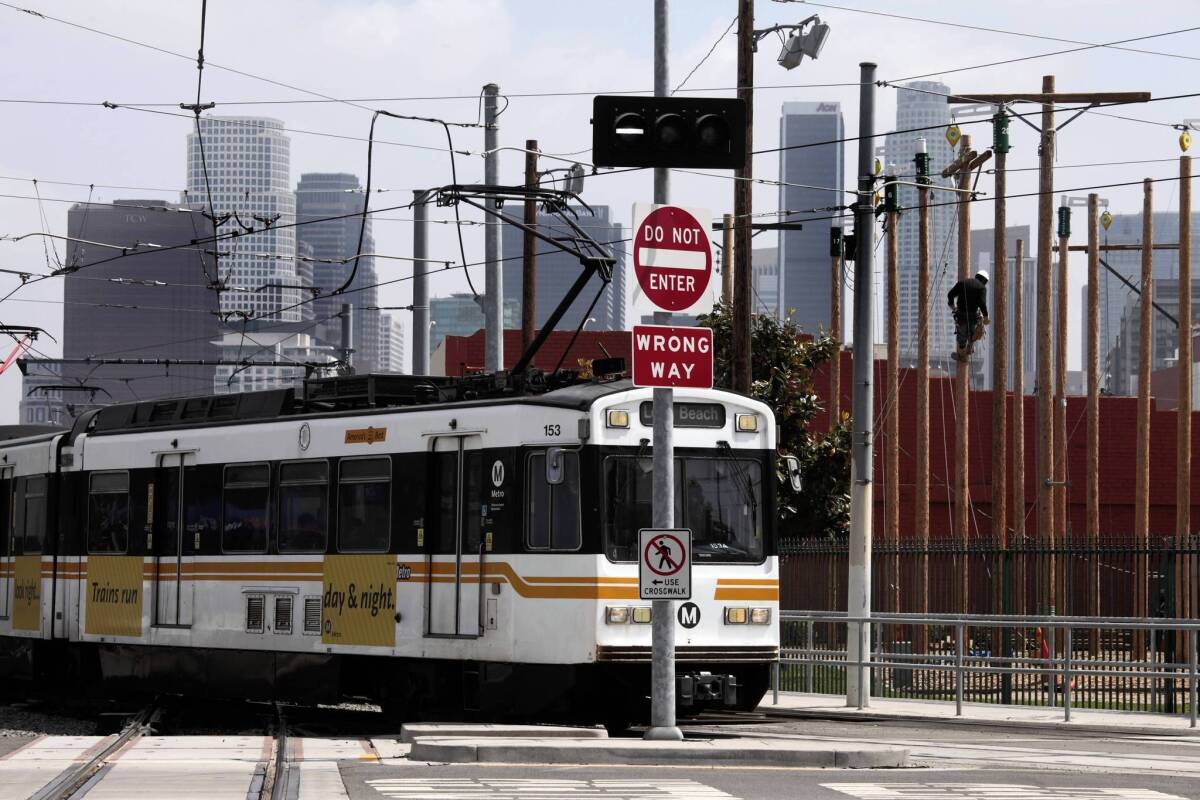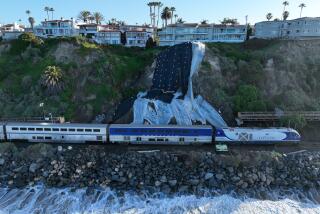Fix for flawed light-rail junction in downtown L.A. is outlined

Local transit officials Tuesday outlined plans to permanently repair the flawed intersection of two light-rail lines in downtown Los Angeles that had raised safety and maintenance concerns.
The Los Angeles County Metropolitan Transportation Authority asserts that the repair should prevent further problems at Washington Boulevard and Flower Street, the busiest junction in Metro’s 87-mile rail network.
Officials plan to slightly narrow the width between the rails along 15 feet of track where the popular Blue Line curves to merge into the recently opened Expo Line before the route heads into the Metro Center station. About 32 trains an hour now pass through the intersection.
The fix is expected to eliminate excess play in the track that was causing train wheels to slam into a small section of the junction, resulting in excessive wear to wheel assemblies and a critical piece of the layout known as a “frog” that guides rail cars through a switch. According to an earlier Metro report, the flaw presented a risk of derailment on the Blue Line.
“It is safe now and we will keep it safe,” said Frank Alejandro, Metro’s chief operating officer. “That is our commitment to our customers and to our employees.”
Officials for Metro and the Exposition Construction Authority, which built the Expo Line to the Westside, said the repair can be made during a weekend in the months ahead, minimizing service disruptions. When the work will begin and what it will cost have not been determined.
The repair is one of three options presented this month by ZetaTech, a New Jersey-based rail consulting firm hired by rail officials to analyze the junction.
According to the company’s report, the problem was caused by a design that did not comply with standards put forth by the American Railway Engineering and Maintenance of Way Assn. Among other things, the width between rails was 4 feet, 9 inches, in parts of the junction where it should have been 4 feet, 8 1/2 inches.
The company also concluded that the junction has been safe since Metro made temporary modifications, began a stringent inspection program imposed by the California Public Utilities Commission and limited train speeds through the intersection to 5 mph. The Blue Line normally travels through the intersection at 10 mph, and Expo trains go through at 35 mph.
Michael Harris-Gifford, Metro’s chief executive of wayside systems, said that two other solutions proposed by ZetaTech were not practical because they would reduce the number of trains and remove some traffic lanes.
The track alignment problem was first noticed in April 2010, when Metro officials discovered excessive wear and damage to wheel flanges and the pins that hold wheel assemblies to Blue Line cars. Internal agency reports state that the defect presented a potential risk of derailment in the junction or elsewhere on the Blue Line.
Trying to avoid the cost and service disruptions that would be required to replace flawed tracks, transit officials attempted to solve the problem by welding a bulb of metal to the frog and lengthening rail guides for train wheels. The weld, however, has had to be redone twice because of cracking.
In July, the utilities commission noted the failed welds and recommended that the damaged frog be replaced. Since then, Metro and Expo hired ZetaTech to help come up with a permanent solution. Once the repair is made, Harris-Gifford said, Metro and Expo officials plan to meet with the commission.
More to Read
Start your day right
Sign up for Essential California for news, features and recommendations from the L.A. Times and beyond in your inbox six days a week.
You may occasionally receive promotional content from the Los Angeles Times.







